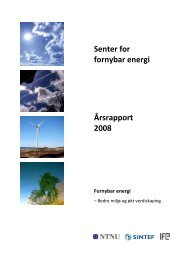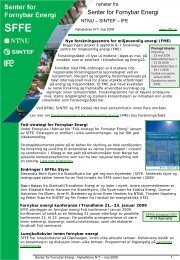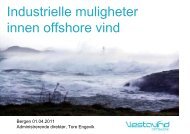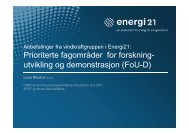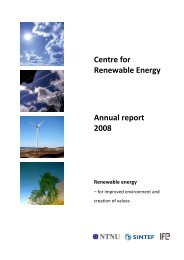R&D Strategy for Renewable Energy - SFFE
R&D Strategy for Renewable Energy - SFFE
R&D Strategy for Renewable Energy - SFFE
Create successful ePaper yourself
Turn your PDF publications into a flip-book with our unique Google optimized e-Paper software.
18<br />
Fields of interest<br />
Kapitteltekst<br />
Fields of interest<br />
19<br />
Resource<br />
Norway holds a strong<br />
position regarding<br />
the development of<br />
second generation<br />
biofuels and advanced<br />
systems <strong>for</strong> bioenergy<br />
85% of the energy use<br />
in Norwegian buildings<br />
comes from<br />
electricity<br />
Technology<br />
Research<br />
and innovation<br />
Figure: The value chains of bioenergy<br />
Industrial development<br />
and value creation<br />
<strong>Energy</strong> services<br />
constitute 2% share of the fuel sales in this country by<br />
2008 and 5% by 2009.<br />
It is estimated that there is a potential <strong>for</strong> increasing<br />
the energy production from biomass by 15-30 TWh annually<br />
in Norway, basically from wood. With a fuel cost<br />
of €0.014/kWh, it is considered that the production of<br />
biomass from wood <strong>for</strong> heating purposes can increase<br />
by up to 15 TWh.<br />
The greatest research ef<strong>for</strong>t that is needed regarding<br />
bioenergy, is in second generation biofuels. We<br />
consider Norway to be in a strong position, due to its<br />
long-standing competence from the paper and processing<br />
industry, and its extensive unused <strong>for</strong>est resources.<br />
Recommendations<br />
An R&D initiative on bioenergy in Norway should be<br />
focused on<br />
› The development of large-scale advanced systems<br />
<strong>for</strong> co-generation of biofuels and electricity or<br />
heat from biomass. The entire value chain should<br />
be analysed, and the characteristics of the fuel as<br />
well as the environmental consequences should be<br />
taken into account.<br />
› The utilization of microorganisms <strong>for</strong> biofuel<br />
production, based on fermentation of sugar from<br />
cellulose, which <strong>for</strong> a long time has been under<br />
investigation internationally. More attention should<br />
be given to these processes in Norwegian R&D.<br />
› Investment in laboratory infrastructure as well as<br />
facilities <strong>for</strong> demonstration of new technology.<br />
4.5 <strong>Renewable</strong> heat and energy savings<br />
<strong>Renewable</strong> heat refers to solar heat, bioheat and heat<br />
pumps, whereas energy savings includes all measures<br />
to reduce the need <strong>for</strong> primary energy in buildings.<br />
Approximately 50 TWh/year is spent <strong>for</strong> heating<br />
each year in Norwegian buildings. New regulations<br />
introduced in 2007 demand a reduction of 25% in the<br />
energy use in new buildings compared to the traditional<br />
standards. Over the last few years, the interest<br />
<strong>for</strong> low-energy and passive houses has also increased.<br />
Low-energy houses are defined as houses with at least<br />
50% lower energy use than the normal and passive<br />
houses with at least 75% less. There are today approximately<br />
10 000 low-energy houses under planning or<br />
construction in Norway.<br />
Solar heating has become increasingly popular<br />
internationally, but has not yet experienced a breakthrough<br />
in Norway. It is calculated that there is a practical<br />
potential of 4 TWh/year <strong>for</strong> solar heat utilization<br />
in Norway.<br />
The number of installed heat pumps has increased<br />
over the last ten years. In 2004, 150 000 heat pumps<br />
were installed, with a total production of 6 TWh/<br />
year of heat. The price of heating from heat pumps is<br />
considered competitive to alternative sources. There is,<br />
however, no large producer of heat pumps in Norway<br />
and suppliers rely on imports.<br />
The estimated potential <strong>for</strong> energy savings and<br />
the use of renewable heat are respectively 12 TWh/<br />
year and 10 TWh/year. For heat pumps, the realistic<br />
potential is estimated to 10-16 TWh/year.<br />
The greatest opportunity <strong>for</strong> innovation in these areas<br />
in Norway is within the development of integrated<br />
solutions <strong>for</strong> buildings that combine energy savings<br />
and heat utilization. Further innovations make it <strong>for</strong>eseeable<br />
to produce houses, combining renewable heat<br />
utilization with power generation systems, which are<br />
net producers of energy.<br />
Recommendations<br />
› Increasing the knowledge in the construction business,<br />
regarding development and implementation<br />
of low energy solutions<br />
› Gradually intensify the regulations <strong>for</strong> energy<br />
consumption in new buildings.<br />
› Long-term framework conditions to provide incentives<br />
<strong>for</strong> the use of renewable heat.<br />
› Establishment of long-term R&D programmes <strong>for</strong> the<br />
utilization of renewable heat and energy savings.<br />
4.6 Hydropower<br />
As mentioned, hydropower represents 99% of the<br />
total electricity production in Norway. The hydropower<br />
system is a very favourable one to combine with new<br />
non-controllable energy sources as windpower and<br />
wave energy, as it can balance the power production in<br />
periods of light wind and low waves.<br />
Recently increased attention has been given to<br />
small hydropower systems (less than 10 MW) as most<br />
of the large hydropower resources have already been<br />
utilized in Norway. Small hydropower systems can produce<br />
power at competitive prices. The cost- efficient<br />
potential <strong>for</strong> installation of small hydropower plants is<br />
estimated to be 25 TWh/year.<br />
Modernization of existing plants also represents an<br />
opportunity. The potential <strong>for</strong> upgrading and extending<br />
existing plants has been estimated to 10 TWh/year.<br />
Considerable national competence has been developed<br />
in this area <strong>for</strong> both small and large installations.<br />
This competence has proved to be a good resource <strong>for</strong><br />
exports.<br />
Recommendations<br />
R&D is relevant <strong>for</strong> some areas, as<br />
› The environmental aspects of hydropower systems<br />
› Control systems and maintenance of hydropower<br />
plants.<br />
› Improved turbine designs.<br />
› Utilization of pump turbines.<br />
› Sand erosion in hydraulic machines.<br />
› Enhance efficiency measurement techniques.<br />
R&D is also important to maintain existing competence,<br />
and to provide research-based education.<br />
4.7 Tidal and osmotic power<br />
There is increasing interest in energy production<br />
from ocean energy like tidal <strong>for</strong>ces, wavepower and<br />
osmotic energy. Tidal power has an energy concentration<br />
of 500 to 1000 W/m2 on the Norwegian coast. A<br />
prototype of a tidal water turbine has been installed<br />
in Hammerfest in northern Norway by Hammerfest<br />
Energi. The experience gained from this prototype will<br />
lead to the installation of a new prototype, which will<br />
be installed in Scotland due to better framework conditions.<br />
Tidal power is not a strong resource in Norway,<br />
but can be exploited in certain locations, generally in<br />
the northern parts of the country. However, the Norwegian<br />
competence in offshore installations is considered<br />
to be valuable in the development of new concepts <strong>for</strong><br />
generation of energy from tidal currents.<br />
Osmotic power is based on the energy generated<br />
from mixing freshwater with salt water. The theoretical<br />
osmotic pressure from this mixture corresponds to<br />
a column of 270 m of water. The Norwegian energy<br />
company Statkraft is constructing a pilot plant <strong>for</strong><br />
osmotic power of 10 kW, starting in 2008. Statkraft<br />
has estimated a realistic potential of 12 TWh/year of<br />
installed osmotic power in Norway.<br />
Recommendations<br />
These are immature technologies, which need substantial<br />
R&D to become commercially viable. Tidal power<br />
is dependent on development of low-maintenance<br />
solutions and light gear-free generator systems.<br />
Osmotic power is dependent on a clear R&D initiative<br />
to increase the efficiency of the membranes needed to<br />
separate and transport water.<br />
There is a large potential<br />
<strong>for</strong> innovations<br />
on energy savings in<br />
buildings<br />
Hydropower represents<br />
99% of the total<br />
electricity production<br />
in Norway<br />
The development of<br />
concepts <strong>for</strong> tidal and<br />
osmotic power is in its<br />
early stage<br />
Centre <strong>for</strong> <strong>Renewable</strong> <strong>Energy</strong> – <strong>for</strong> a better environment and increased value creation<br />
Centre <strong>for</strong> <strong>Renewable</strong> <strong>Energy</strong> – <strong>for</strong> a better environment and increased value creation






